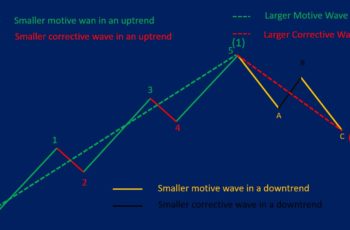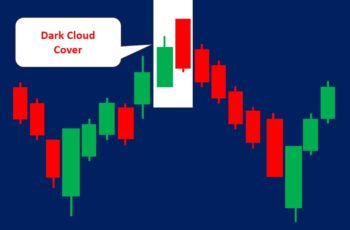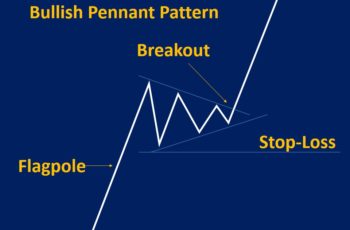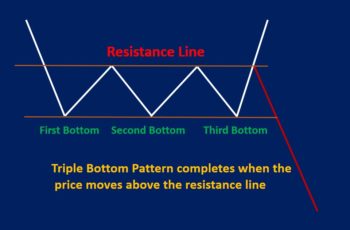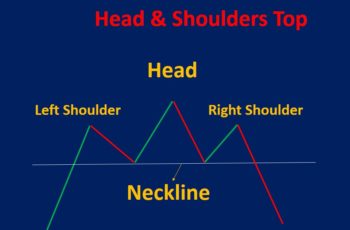A hammer candlestick pattern is a reversal structure that forms at the bottom of a chart.
There are two types of hammers: regular and inverted hammers.
This article illustrates these patterns in this order: What is a hammer? How to trade a hammer? And give you examples. And, What is an inverted hammer? How to trade it? And, gives you examples. Additionally, it explains the differences between a hammer and a hanging man.
What Is a Hammer Candlestick?
A hammer candlestick is a single bullish reversal candlestick pattern. It forms at the bottom of a trend and suggests a future uptrend.
A hammer candlestick has a long lower shadow, a small body at the top of the candle, and no or a tiny upper shadow. Technically, the length of its shadow should be at least twice the size of its body.
A hammer means the bulls are serious about fighting. They want to push the price higher. And, they succeed somehow closing the price near the top of the candle.
The color of the hammer and inverted hammer candlesticks do not matter. They can be green or red.
How to Trade Hammer Candlestick?
A hammer is not an extremely potent pattern. So, be careful trading hammer candles.
To be reliable, a hammer should have some of the following features:
- A hammer should appear after a long trend or at the end of a correction chart pattern. It is not reliable if establishes three or four candles after a trend reversal, or one candle in a correction pattern.
- Its lower shadow should be long enough. A long shadow confirms the strength of bulls trying to push the price upward.
- Look for technical supporting signals for the hammer, such as charts, indicators, support lines, and resistance lines. The candles before a hammer can tell you whether the trend is weakening or not.
- Check out the economic calendar, and blend your hammer analysis with fundamental analysis.
- If you are convinced by signals, buy as the hammer is completed, or close your already short position if you have one. Moreover, put your stop loss a little bit lower than the lowest price of the hammer.
More supporting signals for the hammer, lead to a higher chance of reversal. It does need confirmation by other techniques due to being a single pattern.
Example of Hammer Candlestick Pattern
In the following chart, the S&P 500 index, made three hammers. The first hammer signaled a reversal and two others made a new support line.
The red hammer on the first march was a hammer because it formed after a correction. This hammer was the first candle that warned of the resumption of the uptrend. And, the Relative Strength Index (RSI) supported the hammer by showing it as an overbought level.
After the formation of a tweezers, the trend reversed.
Another hammer appeared after a few sessions from the top. This candle is a hammer because we are still at the bottom of a trend. The RSI MA crossed the RSI main line and confirmed the star of a new direction.
On 16th August, a potent hammer formed. This hammer was a good signal because it was green and its lower shadow length is almost 3%. Moreover, the bottom of this hammer is near the support area created in March, which is another supporting signal.
Buying after the first hammer was not a good idea, because only the RSI confirmed it. Going long after the second and the third hammer were amazing opportunities. In the case of the two latter hammers, there was more than one supporting signal. For example, the second hammer was supported by the RSI, the first hammer, and the tweezers. Confirmers of the third hammer were the first two hammers, the tweezers, and formed after a long downtrend.
What Is an Inverted Hammer Candlestick?
The inverted hammer candlestick pattern is the flipped hammer, also a single candle pattern.
In other words, an inverted hammer has a tiny body near the bottom of the candle and a tall upper shadow.
An inverted hammer is also a bullish pattern however, it is less reliable than a regular hammer.
During a downtrend, an inverted hammer means that bulls tested the market and may try again. This is a warning signal for bears.
As mentioned earlier, the color of the hammer and inverted hammer candlestick can be both green or red.
How to Trade an Inverted Hammer Candlestick?
The inverted hammer candlestick is a bullish reversal pattern but not potent.
It implies that bulls tried pushing the price higher however the bears defeated them. This defeat requires caution.
Here are some factors to consider while you discover an inverted hammer:
- A significant downtrend should be present before an inverted hammer. Even a lengthier downtrend should be present than the downtrend needed for a hammer.
- Never trade an inverted hammer without powerful supporting signals. As mentioned, it is less reliable than a hammer. So, blend it with other tools’ signals, such as Fibo tools and indicators.
- Change the time frame of the candles to a lower one to see what happened yesterday. It gives you more clue if it does worth to risk or not.
- Check out the economic calendar, and blend your analysis with fundamentals to see if they support the inverted hammer.
- Buy or close your short position after the completion of the inverted hammer if there are enough shreds of evidence.
Trading the inverted hammer requires huge cautions. You can not trust it too much. It only tells that bulls tried but failed. And, there is a chance of another try for bulls.
Example of Inverted Hammer Candlsetick
In the following chart, the S&P 500 made two inverted hammers. The first was on 26 January and the second was on 08 March 2022.
Three signals supported the hammer on 26 January. The first signal was triggered two days before this pattern by a strong hammer. The second signal is the 4260 price level which many candles tried to break but failed. And, finally, the third signal was made the RSI indicator by showing an overbought condition.
Buying after the first inverted hammer seems risky because the downtrend was not long enough. If you buy in places like this try to manage your position by changing stop loss or accepting a small loss if the price fell.
The second inverted hammer warned the bears. The next green candle together with the inverted hammer made a tweezers, which is a good confirmation. After a few volatile sessions, finally, the new uptrend started. And, this inverted hammer which made a tweezers with a green candle, played the role of a strong support line.
Buying after the second inverted hammer from a risk/reward perspective looks enticing. It formed after a long downtrend, and previously other candles were predicting a possible future uptrend. If the inverted hammer did not convince, the next session was a long green candle, which together made a tweezers. Putting stop loss somehow lower than the low price of the tweezers was a good idea.
What Is the Difference Between a Hammer Candlestick and a Hanging Man?
Hammer candlestick and hanging man are reversal patterns. They both have long lower shadows and a small body at the top.
However, there are big differences between them, and they are:
- A hammer is a bullish pattern while a hanging man is bearish. It means that a hammer forms at the bottom and a hanging man at the top.
- Hammer patterns are more powerful in reversing the trend than the “hanging men” candlestick pattern.
Here is an image showing the difference between a hammer and a hanging man.
Example of Hammer and Hanging Man
In the following chart, the candle on 06 October 2021 is a hammer. Because it has a long lower shadow, it is at the bottom of a trend and has a small body at the top.
A hanging man is labeled on 23 November 2021. This candle is a hanging man because it appeared after an uptrend and has a small body at the top.
The candlestick on 10 January 2022 is not a hammer and a hanging man either. It is not a hammer, because it did not appear after a significant downtrend or at the end of a bullish correction pattern, and the RSI did not suggest the end of a correction. It is not a hanging man either, because it did not appear after an uptrend.
Final Thoughts
Hammer and inverted hammer candlesticks form at the bottom of a trend and suggest a future uptrend.
However, they are potent patterns. You need confirmation by other fundamental and technical tools.

